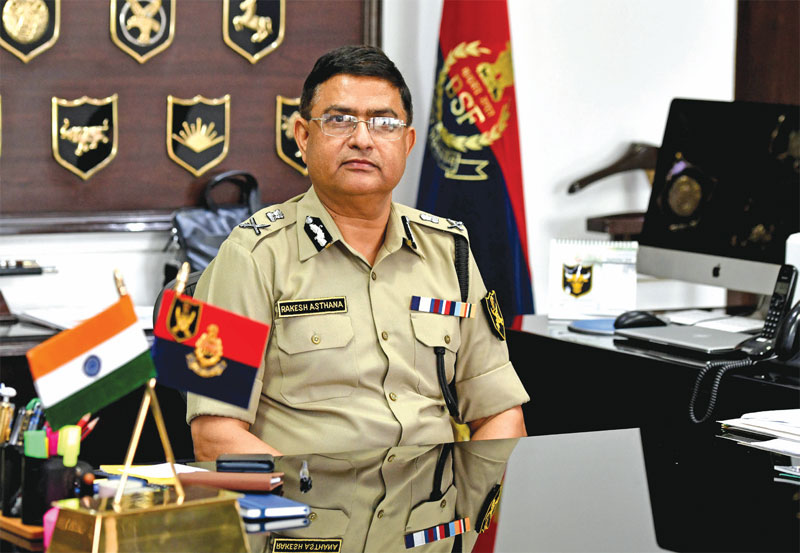Our Training Methodology Has Evolved With a Vision to Deal with the Unconventional Situations and Techniques

What is the current force level of the BSF? How many battalions currently exist within Force?
The Border Security Force (BSF) presently has 192 battalions including three National Disaster Response Force (NDRF) battalions. With its Force Headquarters (HQs) in New Delhi, BSF ORBAT comprises three command HQs, Eastern Command at Kolkata, Western Command at Chandigarh, and Command HQ Special Ops at Raipur. In addition to that, it has 13 Frontier Headquarters and 46 Sector Headquarters. The BSF is the only border guarding force that can boast of its own Water Wing, Air Wing, Artillery Units, Tear Smoke Unit (TSU), Central Workshop and Store (CENWOSTO) and other ancillary units.
In addition, the BSF also has well established set-up of training institutions that cater for equipping field commanders and troops with the necessary strategic and tactical knowledge and wherewithal required to tackle emerging challenges.
How has the training evolved with growing numbers of personnel and changing nature of threats?
Training in the BSF is a continuous and progressive process to ensure that we are always prepared for the dynamically changing security scenario. The importance of maintaining combat worthy troops to deal with any situation on our borders as well as internal security duties like counter Maoist, counter insurgency and counter terrorist operations cannot be over emphasised.
In the BSF, we have basic training for newly recruited constables, subordinate officers and officers. We also have various ‘in-service courses’ and ‘role and situation’ specific training programmes to hone up various skills of our bordermen to their optimum level and enthuse their professional acumen. With the increasing number of personnel in the BSF, training of our troops has been a challenge and to overcome this situation we have over a period of time raised many new training institutions and augmented the training capabilities and infrastructure of the already existing training centres.
Due to the prevailing geopolitical scenario of South Asia, threats to our country are no longer merely conventional. Our adversaries and anti-national elements within the country are using and adopting rapidly changing technologies, equipment and strategies to destabilise the overall security situation in the country. Our training methodology has evolved with a vision to deal with these unconventional situations and techniques. We review our training process from time to time through ‘need analysis’ and embrace various new technologies and methodology to incorporate them into our training process so that our troops are always well-prepared for all eventualities.
How has the BSF kept pace with modernisation? What new technologies have been adopted?
The BSF has embarked on the path of modernisation and is adopting new technology through major programmes covering all fields of operations including acquisition of latest weaponry and communication and surveillance systems. We are also acquiring modern watercraft etc. The BSF has already completed its modernisation Plans I and II and is adopting various modern gadgets and technologies to stay abreast with time for better management and domination of border. Modernization Plan-III has been introduced with the sanction of Cabinet Committee on Security for the period from 1 April 2018 to 31 March 2020 and extended until 31 March 2021. The common themes of modernisation plan are:
- Protective Equipment Solutions
- Surveillance Solutions
- Night Fighting Dominance
- Better Fire Power
- Non-Lethal Riot Control Equipment
- Fool-Proof Communication
- Battle Field Management System
- Training Aids; and
- Miscellaneous Equipment
Further, as part of the Comprehensive Integrated Border Management System (CIBMS), technological solutions are being used for vulnerable areas. It involves integration of various sensors and surveillance equipment with suitable command and control system.
What is the status of the fence on the Eastern border?
Of the 4,096.7km length of the International Border (IB) along India-Bangladesh border, 3,116.324km is fenced. 980.376km of the IB remains to be covered with the fence.
How are ceasefire violations on the border with Pakistan being tackled?
The BSF never violates the ceasefire. However, a fitting reply is given to ceasefire violations as per the guidelines of government of India. On IB of Jammu and Kashmir, Pakistani forces carried out cross-border firing on 242 occasions from January 2020 to 15 August 2020.
You must be logged in to view this content.

